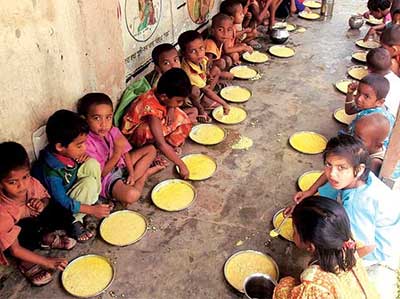Relevance: GS-2: Government Policies and Interventions for Development in various sectors and issues arising out of their Design and Implementation.
Key Phrases: Inter-Ministerial Panel, Food Security, National Food Security Act (NFSA), Malnutrition, Integrated Child Development Scheme, Mid-Day Meal Scheme, National Family Health Survey-5 (NFHS-5), protein-rich food, Micronutrients.
Why in News?
- An inter-ministerial panel has recommended significant changes to the National Food Security Act (NFSA).
About the committee:
- The inter-ministerial committee includes officials from the Ministry of Food, the Ministry of Health, the Ministry of Women and Child Development, and the Ministry of Education, as well as scientists from the Indian Council of Medical Research (ICMR) and the Food Safety and Standards Authority of India (FSSAI).
Key observations:
- Impact of Covid-19 pandemic:
- It is likely to have “aggravated the silent crisis” of malnutrition.
- Failure of protein-rich norms:
- Guidelines of programmes such as the Integrated Child Development Scheme and the Mid-Day Meal Scheme do have protein-related norms but, by all accounts, most state governments have failed to do adequate justice to them.
- Eggs, for instance, are served in mid-day meals in only 13 states and three Union Territories.
- State governments often cited food-related sensitivities to oppose their inclusion in nutritional programmes.
- Concerns over NFHS-5 data:
- The percentage of anaemic children up to the age of five, for instance, has gone from 59 per cent in the last survey to 65 per cent.
- At the same time, obesity has gone up in children of all age groups.
- This suggests unhealthy eating habits and the absence of micronutrients in diets.
- Inadequacy of stocks of vitamins and minerals:
- Anganwadi and schools need to have adequate stocks of capsules of vitamins and minerals.
- But several reports and surveys have revealed that this is not always the case.
Features of NFSA 2013
- Coverage and entitlement: Up to 75% of the rural
population and 50% of the urban population will be covered under the
Targeted Public Distribution System (TPDS), with a uniform
entitlement of 5 kg per person per month.
- Antyodaya Anna Yojana (AAY) households-35 kg per household per month
- Subsidised prices: Foodgrains under TPDS will be made available at subsidised prices of Rs. 3/2/1 per kg for rice, wheat and coarse grains.
- Identification of Households: It is to be done by States/UTs.
- Eldest woman of the beneficiary household (18 years or above) is considered as 'Head of Family' to issue ration cards.
- Grievance Redressal Mechanism: Grievance redressal mechanism at the District and State levels.
- Maternity Benefit: Pregnant women and lactating mothers will also be entitled to receive maternity benefits of not less than Rs. 6,000.
- Transparency and Accountability: Provisions have been made for disclosure of records relating to PDS, social audits and setting up of Vigilance Committees to ensure transparency and accountability.
Key Recommendations:
- Legal mandate for protein-rich food:
- The committee has sought a legal mandate for the inclusion of protein-rich foods such as eggs, nuts and legumes in nutritional schemes at the school and Anganwadi levels.
- Those who do not consume eggs may be provided double the proposed quantity of nuts and seeds.
- Incorporation of micronutrients:
- Schedule II of the National Food Security Act lays down nutritional standards for government food safety programmes like mid-day meals, PM Poshan and Integrated Child Development Services scheme.
- Currently, it quantifies nutrition per meal in terms of calories and protein only, but the inter-ministerial panel has called for micronutrients to also be taken into account.
- It recommends the incorporation of micronutrients — iron, zinc, vitamin C, vitamin B12, folic acid, vitamin A and vitamin B2 — in diets instead of the purely calorie-centric approach of the NFSA.
- A legal mandate for micronutrients could be the first step toward pushing the Centre and state governments to address this deficit.
- Cost implications:
- According to the cost implications of the recommendations, the cost
per meal in lower primary classes will be Rs 9.6 and Rs 12.1 in upper
primary.
- This excludes milk and fruits.
- Currently, the cooking costs are Rs 4.97 and Rs 7.45 respectively.
- According to the cost implications of the recommendations, the cost
per meal in lower primary classes will be Rs 9.6 and Rs 12.1 in upper
primary.
What is the difference between Food Security and Nutrition Security?
- The ultimate goal of nutrition security is more significant than just food security.
- Although food intake might follow guidelines (aimed at achieving food security), intestinal parasites, for instance, can reduce nutrient uptake and thereby limit nutrient security. Thus, a better phrase would be simply ‘nutrition security’: nutrition security encompasses food security, which encompasses nutrient content. It is about a community’s access to essential nutrients, not just calories.
Source: Nature.com
Conclusion:
- Right to food is not only a statutory right but also a human right.
- Despite being in place for more than nine years, the NFSA has, at best, led to marginal improvements in the nutritional status of people in large parts of the country.
- Care should be taken to make sure that the meal comprises healthy ingredients in the first place.
- There is a need to incorporate a broader definition of nutrition security. This will help in addressing the hunger of millions and achieving sustainable development goals.
Source: The Indian Express
Mains Question:
Q. A legal mandate for protein and micronutrient-rich food through an amendment to National Food Security Act (NFSA) can help handle malnutrition. Examine.







